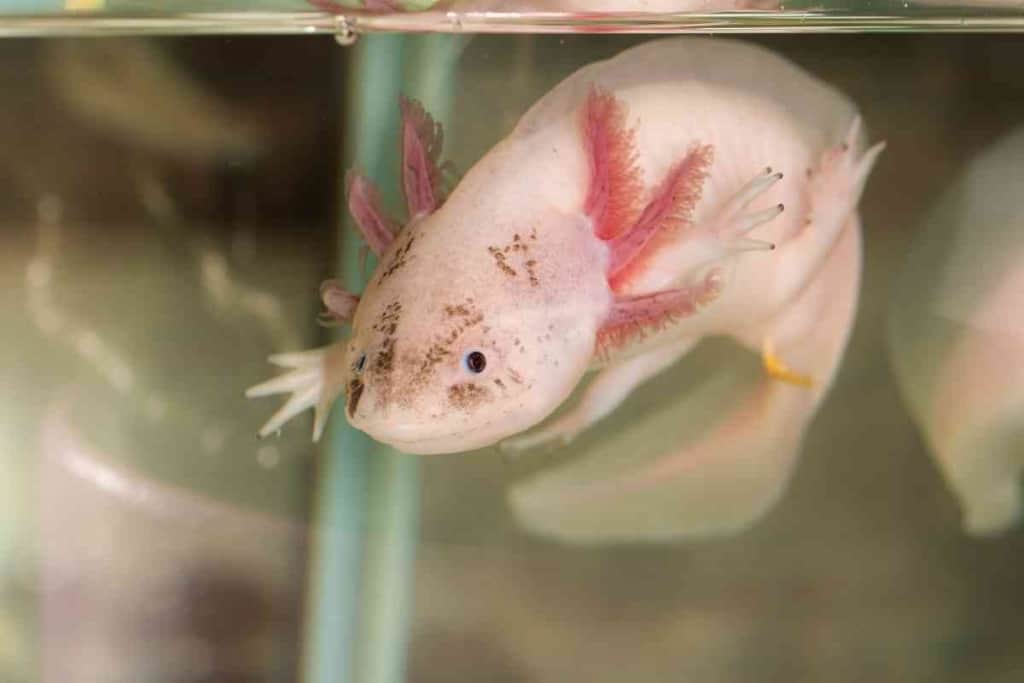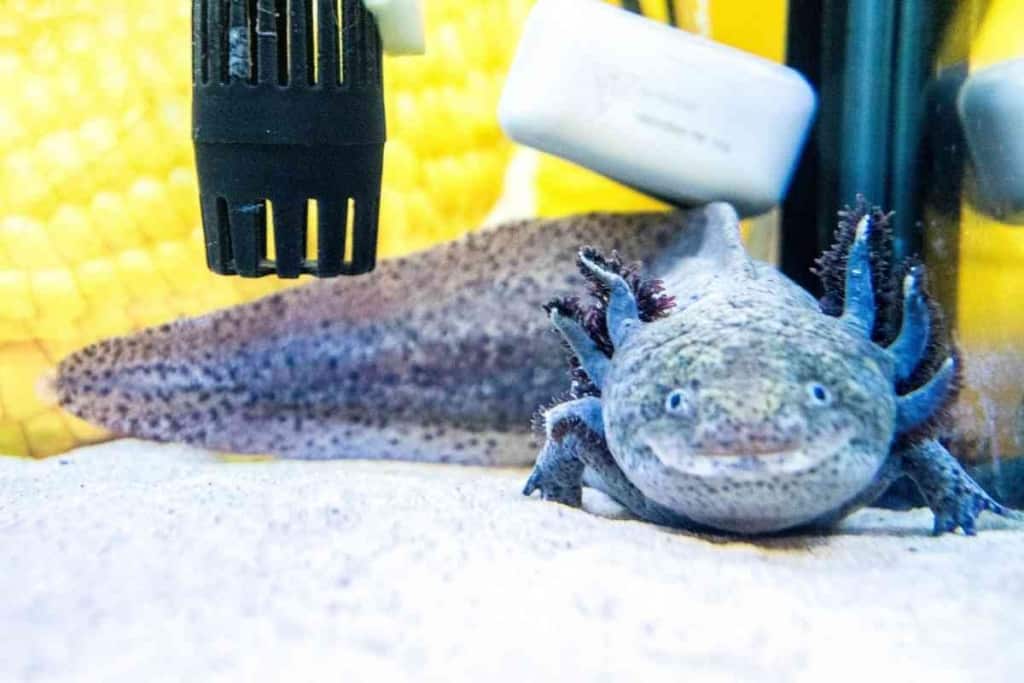How Far Can Axolotls Jump?
As conservation laws change in the United States, many people are looking to all kinds of new amphibians for pets, including axolotls. These small creatures resemble tadpoles as infants but have front and back legs as adults. As a result, in adulthood, axolotls can pose many difficulties for their owners by jumping. How far can axolotls jump, and does it pose a risk?

How far can an axolotl jump?
In maturity, axolotls exhibit jumping skills comparable to many frogs, newts, and salamanders. An adult can clear a tank wall measuring 12 inches high, despite its small length of only about 25 centimeters on average.
While there isn’t much public science about exactly how high axolotls can jump, owners know that they are capable of leaping over tank walls. It is critical to be thorough regarding the type of aquarium you use and how you clean it. Otherwise, axolotls will leap out and cause potentially lethal trouble for themselves.
Let’s discuss how high axolotls can jump and whether it poses a risk. After, you’ll learn how to pick and proof your aquarium and how to handle the pets during tank cleaning.
Do Axolotls Jump?
Yes, just like frogs and many other amphibians, adult axolotls can and will jump.
After about two weeks of incubation, axolotl eggs hatch. Two more weeks later, the young usually develop front legs, and after another interval, they gain back legs. However, they aren’t great at jumping until they reach full maturity at around six months of age. Until your axolotls are about six months old, there’s virtually no risk of jumping out of the aquarium.
In maturity, axolotls exhibit jumping skills comparable to many frogs, newts, and salamanders. An adult can clear a tank wall measuring 12 inches high, despite its small length of only about 25 centimeters on average.
The springy amphibians get lots of horizontal distance, just like frogs. Axolotls can jump farther from their tank than you expect.
Not only can axolotls jump, but they often do when the opportunity arises. The amphibians are known for their escape attempts when owners remove the tank lids. To account for axolotls jumping, apply safety measures to ensure the creatures’ safety.
Why Do Axolotls Jump?

There are two main reasons why axolotls jump. Either they are leaping at food or want to escape their environment.
Axolotls like to jump when they feed. When they suck in water to consume pellets, sometimes they exhibit so much force that they lift themselves, causing them to jump. If the axolotl food sits on the surface of high water, it isn’t difficult for the creatures to jump out of the aquarium.
Axolotl Stress
The other reason axolotls might jump is to escape their environment. Generally, they do this due to stress caused by poor water quality or lack of enrichment. Axolotls are very sensitive to water conditions like temperature and pH like other amphibians.
Keep the water in your aquarium cool, as axolotls prefer temperatures between 60 and 68 degrees Fahrenheit, or between 16 and 18 Celsius. The amphibians prefer the pH range to rest between 6.7 and 7.4, a level comparable to their natural environment.
Axolotls exhibit physical symptoms when they are stressed and unhappy. The creatures will refuse to eat, and their gills will curve forward. Poor skin quality and a bloated abdomen also indicate stress, usually due to disease. A folding tail tip and hunched floating are other signs.
A lack of enrichment can cause unhappiness in axolotls. Amphibians do not require much stimulation, but interactions with others of their species, a large tank, and many hiding spaces suit them well. Synthetic silk or real plants are a great way to manage the water quality while simultaneously providing the shelter axolotls need.
If you take care of those needs and your axolotl is still stressed, consult an amphibian veterinarian for treatment options and suggestions.
Does Jumping Put Axolotls in Danger?
Unfortunately, yes, axolotls can put themselves in danger by jumping. Although these amphibian creatures have both gills and lungs, a typical member can only survive for about an hour outside water. They are fully aquatic creatures, and jumping out onto dry land can endanger their lives.
The larger an axolotl is, the longer it can survive without water. Still, at most, expect your pet to only live for an hour. However, if you respond quickly, axolotls can fully recover.
What Do I Do If My Axolotl Jumps Out?
If your axolotl jumps out or you notice it missing from an open-top aquarium, you need to find it quickly. Search the immediate area and look for water trails to help locate the creature. When you do, return it to its tank and do not touch it for too long. Axolotls and other amphibians are sensitive to the oils in human skin.
After returning your axolotl, you should assume it is unhappy with its tank. Check the pH and temperature and clean the aquarium if necessary. Finally, to prevent future incidents, install a lid on the top of your tank.
How Do I Jump-Proof My Axolotl Tank?
Vets and enthusiasts recommend a 10 to 20-gallon tank for axolotls. A standard ten-gallon tank is about 20 inches long, 12 inches tall, and ten inches wide. Axolotls can still jump over the walls of a tank this size, however. That’s why the most critical safety measure an owner can provide is to place a lid on top of the aquarium.
Lids will not only deter the axolotls from jumping, but they also protect the creatures from outside threats. Anything from poor air quality to mischievous house cats can cause stress or damage the amphibians, shortening their lives.
Another way to jump-proof your axolotl tank is to avoid filling it with high piles of terrain. Whether it is sand, gravel, or a plastic outcrop, the amphibians do not need these islands above the surface since they are fully aquatic. Any items like these that you include in the tank give axolotls a higher point to jump from, potentially helping them escape.
Not only do they survive fine in water, but the water also lessens the strength of their back legs, making their jumps lower. However, if you fill the water level too high, it can aid them in leaping over the tank walls.
Safe Tank Cleaning
Do not displace your axolotl in a dish during cleaning. Doing so will increase the risk of the axolotl jumping and hurting itself. If you need to deep clean a tank, create a reserve tank with the same conditions and transplant your pet carefully.
Axolotls typically fare well staying in place while you siphon and filter their water a fraction at a time. Remove between 20 and 25% of the aquarium water weekly, replacing it with fresh, pH-tested water. Guard the surface of the aquarium carefully, especially if you remove a lid during the exchange.
Conclusion
How far can axolotls jump? Now you know that the amphibians can surmount even a foot of vertical distance.
Axolotls are exotic amphibians with a distinct look. They are fragile and sensitive creatures, however, and they thrive best in a tank full of adequate water. If your axolotl is trying to jump out, be sure that its conditions are suitable. If you’re ever unsure of how to improve your pet’s quality of life, seek a veterinary specialist for a dedicated analysis.
